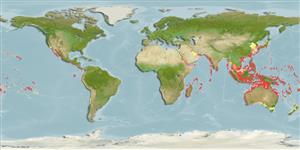Common names from other countries
Classification / Names / Names
ชื่อสามัญ | ชื่อพ้อง | Catalog of Fishes (gen., sp.) | ITIS | CoL | WoRMS
Environment: milieu / climate zone / depth range / distribution range
นิเวศวิทยา
; ระดับความลึก 0 - 65 m (Ref. 101209). Tropical
Indo-Pacific.
Length at first maturity / ขนาด / น้ำหนัก / Age
Maturity: Lm ? range ? - ? cm Max length : 9.5 cm SHL เพศผู้/กระเทย; (Ref. 349); common length : 4.0 cm SHL เพศผู้/กระเทย; (Ref. 349)
The common species is collected for food by coastal people in many parts of the area (Ref. 349). Inhabits rocky and coral-rock bottoms, or on stones and larger shells. Also found in shallow subtidal zones (Ref. 349). Members of the family Patellidae graze on encrusting lichens and algae, or scrape tissue from kelp (Ref. 349).
Life cycle and mating behavior
วัยเจริญพันธุ์ | การสืบพันธุ์ | การวางไข่ | เซลสืบพันธ์ของเพศเมีย(ไข่) | ความดกของไข่ | ตัวอ่อน
Members of the order Archaeogastropoda are mostly gonochoric and broadcast spawners. Life cycle: Embryos develop into planktonic trocophore larvae and later into juvenile veligers before becoming fully grown adults.
Poutiers, J.M. 1998. (Ref. 349)
IUCN Red List Status (Ref. 130435)
CITES status (Ref. 108899)
Not Evaluated
Not Evaluated
Threat to humans
Harmless
Human uses
| FishSource |
เครื่องมือ
ข้อมูลเพิ่มเติม
Age/Size
การเจริญเติบโต
Length-weight
Length-length
สัณฐานวิทยา
ตัวอ่อน
อุดมสมบรูณ์
แหล่งที่มาจากอินเตอร์เน็ต
Estimates based on models
Preferred temperature
(Ref.
115969): 22.3 - 29, mean 27.8 (based on 1014 cells).
Vulnerability
Low vulnerability (10 of 100).
